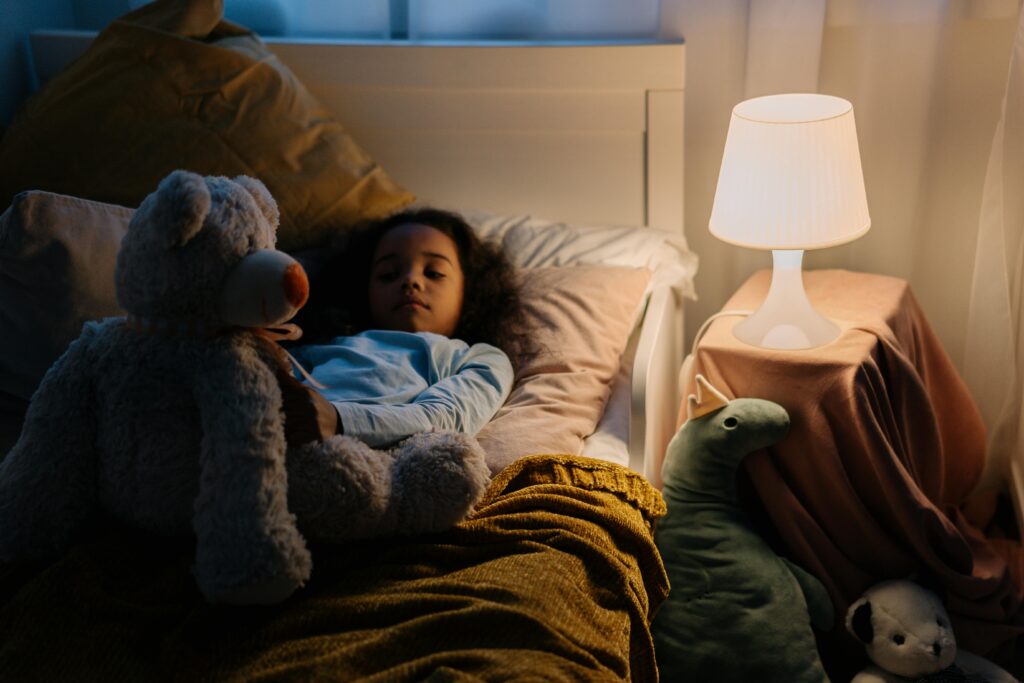As a pediatric sleep consultant—and a mom of two—I’ve seen firsthand how confusing and scary it can be when your child experiences nightmares vs night terrors in children. My own daughter has experienced both, and let me tell you, they are not the same thing.
In this post, I’ll break down the key differences between nightmares and night terrors, share what I’ve learned as both a professional and a parent, and give you practical advice for navigating these challenging sleep disruptions.
What Are Nightmares in Children?
Nightmares are vivid, scary dreams that typically occur during REM (Rapid Eye Movement) sleep, often in the second half of the night. Children usually wake up fully from a nightmare and can remember what scared them. They may seek comfort, cry, or ask to sleep in your bed.
Nightmares are common—especially in children aged 3 to 6—and are often triggered by emotional stress, scary media, or significant life changes. The good news? Children are awake and aware during nightmares, so soothing them is usually straightforward.
What Are Night Terrors in Children?
Night terrors, on the other hand, happen during deep non-REM sleep, usually within the first few hours of falling asleep. They can be intense. My daughter sometimes sits up screaming, drenched in sweat, eyes wide open—but she’s not truly awake. She yells at things that aren’t there, tries to get out of bed, and is completely unaware of me trying to calm her down. It’s heartbreaking and unsettling.
Night terrors are not dreams and children don’t usually remember them. They’re more like a sudden panic response in the brain as it transitions between sleep stages. Triggers can include:
- Overheating (I’ve noticed they often happen when my daughter is too warm)
- Illness or fever
- Stress or fatigue
- Sleep deprivation
Scientific Backing on Nightmares vs Night Terrors in Children
Research suggests that night terrors are a type of parasomnia—a disruption in the transition between sleep stages. Unlike nightmares, they originate from slow-wave sleep.
According to the Sleep Foundation, night terrors affect up to 6.5% of children and typically resolve on their own by adolescence. Their exact cause isn’t always clear, but there’s often a genetic link and environmental factors play a role.
How to Support Your Child Through Nightmares vs Night Terrors
Here are a few things that have helped both my clients and my own family:
- Keep your child’s room cool and comfortable at night.
- Stick to a consistent, calming bedtime routine.
- Limit screen time and stimulating activities before bed.
- Track patterns: When do the episodes occur? Are there clear triggers?
- Don’t try to wake your child during a night terror. Instead, ensure they are safe and gently guide them back to bed if needed.
Supporting your child through nightmares vs night terrors in children can feel overwhelming, but there are simple, effective ways to create a calm and consistent sleep environment.
It’s important to remember that you’re not doing anything wrong. Nightmares and night terrors are part of many children’s sleep journeys—and there is help available.
Understanding nightmares vs night terrors in children is a big step toward helping your little one (and you!) get better sleep—and you don’t have to do it alone.
Need Personalized Support?
If you’re feeling overwhelmed or unsure how to support your child through sleep disruptions like nightmares or night terrors, I’d love to help.
👉 Book a free discovery call to chat about how I can support your family.
Also, check out my curated sleep tools and products that have helped many families (including mine!).
Sources
- National Institutes of Health: Clinical Review of Parasomnias
- Sleep Foundation: Night Terrors
- Mayo Clinic: Night Terrors in Children
You’re not alone in this, and support is just a call away. 💛

COMMENTs